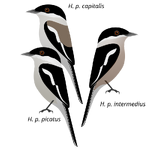m (Created page with "{{Taxobox | name = Stone-curlews | image = Bush Stone-curlew444.jpg | image_width = 225px | image_caption = Bush Stone-curlew, ''Burhinus grallarius'' | regnum = Animalia...") |
m (→External links) |
||
| Line 75: | Line 75: | ||
{{DEFAULTSORT:Stone-Curlew}} |
{{DEFAULTSORT:Stone-Curlew}} |
||
| − | [[Category: |
+ | [[Category:Charadriiformes|*{{PN}}]] |
| + | [[Category:Chionidi|*{{PN}}]] |
||
| − | |||
| + | [[Category:Burhinidae| ]] |
||
| + | [[Category:Families of Charadriiformes]] |
||
Revision as of 22:12, 25 April 2013
| Stone-curlews | |
|---|---|

| |
| Bush Stone-curlew, Burhinus grallarius | |
| Scientific classification | |
| Kingdom: | Animalia |
| Phylum: | Chordata |
| Class: | Aves |
| Order: | Charadriiformes |
| Family: | Burhinidae Mathews, 1912 |
| Genera | |
The Stone-curlews, also known as Dikkops or Thick-knees are a group of largely tropical birds in the family Burhinidae. Despite the group being classified as waders, most species have a preference for arid or semi-arid habitats. They are found worldwide within the tropical zone, with some species also breeding in temperate Europe and Australia.
They are medium to large birds with strong black or yellow black bills, large yellow eyes—which give them a reptilian appearance—and cryptic plumage. The names Thick-knee and Stone-curlew are both in common use, the preference among authorities for one term or the other varying from year to year. The term Stone-curlew owes its origin to the broad similarities with true curlews (which are not closely related). Thick-knee refers to the prominent joints in the long yellow or greenish legs and apparently originated with a name coined in 1776 for B. oedicnemus, the Thick-kneed Bustard.
They are largely nocturnal, particularly when singing their loud wailing songs, which are reminiscent of true curlews.[1]
The diet consists mainly of insects and other invertebrates. Larger species will also take lizards and even small mammals.[1]
Most species are sedentary, but the Stone Curlew is a summer migrant in the temperate European part of its range, wintering in Africa.
Species
The nine species are:
| Picture | Name | Binomial name |
|---|---|---|
| File:Burhinus oedicnemus -central India-8.jpg | Eurasian Stone-curlew | Burhinus oedicnemus |
| No picture | Senegal Thick-knee | Burhinus senegalensis |
| File:Waterdikkop-crop.jpg | Water Thick-knee | Burhinus vermiculatus |
| File:Cape Thick-knees.jpg | Spotted Thick-knee | Burhinus capensis |
| File:Double-striped Thick-knee.jpg | Double-striped Thick-knee | Burhinus bistriatus |
| File:Peruvian Thick-knee (Burhinus superciliaris).jpg | Peruvian Thick-knee | Burhinus superciliaris |

|
Bush Stone-curlew | Burhinus grallarius (formerly B. magnirostris, the Bush Thick-knee). |
| File:Thimindu 2009 09 27 Yala Great Stone Curlew 2.JPG | Great Stone-curlew | Esacus recurvirostris |
| File:Beach Thick-knee Inskip Pt2.JPG | Beach Stone-curlew | Esacus giganteus (formerly E. magnirostris, the Beach Thick-knee). |
References
- ^ a b Harrison, Colin J.O. (1991). Forshaw, Joseph, ed. Encyclopaedia of Animals: Birds. London: Merehurst Press. pp. 105–106. ISBN 1-85391-186-0.
External links
- Thick-knees videos on the Internet Bird Collection

|
This article is part of Project Bird Families, a All Birds project that aims to write comprehensive articles on each bird family, including made-up families. |

|
This article is part of Project Bird Taxonomy, a All Birds project that aims to write comprehensive articles on every order, family and other taxonomic rank related to birds. |
| This page uses Creative Commons Licensed content from Wikipedia (view authors). Please help by writing it in the style of All Birds Wiki! |
